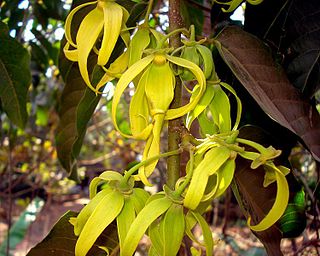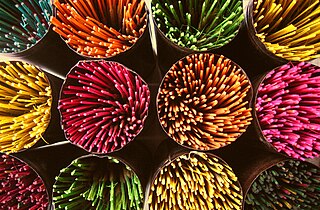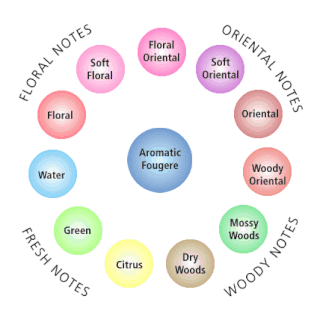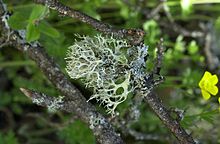Perfume is a mixture of fragrant essential oils or aroma compounds (fragrances), fixatives and solvents, usually in liquid form, used to give the human body, animals, food, objects, and living-spaces an agreeable scent. Perfumes can be defined as substances that emit and diffuse a pleasant and fragrant odor. They consist of manmade mixtures of aromatic chemicals and essential oils. The 1939 Nobel Laureate for Chemistry, Leopold Ružička stated in 1945 that "right from the earliest days of scientific chemistry up to the present time, perfumes have substantially contributed to the development of organic chemistry as regards methods, systematic classification, and theory."

A lichen is a composite organism that arises from algae or cyanobacteria living among filaments of multiple fungi species in a mutualistic relationship. Lichens are important actors in nutrient cycling and act as producers which many higher trophic feeders feed on, such as reindeer, gastropods, nematodes, mites, and springtails. Lichens have properties different from those of their component organisms. They come in many colors, sizes, and forms and are sometimes plant-like, but are not plants. They may have tiny, leafless branches (fruticose); flat leaf-like structures (foliose); grow crust-like, adhering tightly to a surface (substrate) like a thick coat of paint (crustose); have a powder-like appearance (leprose); or other growth forms.

Musk is a class of aromatic substances commonly used as base notes in perfumery. They include glandular secretions from animals such as the musk deer, numerous plants emitting similar fragrances, and artificial substances with similar odors. Musk was a name originally given to a substance with a strong odor obtained from a gland of the musk deer. The substance has been used as a popular perfume fixative since ancient times and is one of the most expensive animal products in the world. The name originates from the Late Greek μόσχος 'moskhos', from Persian mushk and Sanskrit मुष्क muṣka derived from Proto-Indo-European noun múh₂s meaning "mouse". The deer gland was thought to resemble a scrotum. It is applied to various plants and animals of similar smell and has come to encompass a wide variety of aromatic substances with similar odors, despite their often differing chemical structures and molecular shapes.

Cananga odorata, known as ylang-ylang or cananga tree, is a tropical tree that is native to and originated in the Philippines and spread to Malaysia, Indonesia, New Guinea, the Solomon Islands, and Queensland, Australia. It is also native to parts of Cambodia, Thailand, India and Vietnam. It is valued for the essential oils extracted from its flowers, which has a strong floral fragrance. Ylang-ylang is one of the most extensively used natural materials in the perfume industry, earning it the name "Queen of Perfumes".

Used in perfumery and aromatherapy, absolutes are similar to essential oils. They are concentrated, highly aromatic, oily mixtures extracted from plants. Whereas essential oils are produced by distillation, boiling or pressing, absolutes are produced through solvent extraction, or more traditionally, through enfleurage.

Chrysopogon zizanioides, commonly known as vetiver and khus, is a perennial bunchgrass of the family Poaceae.

Limonene is a colorless liquid aliphatic hydrocarbon classified as a cyclic monoterpene, and is the major component in the volatile oil of citrus fruit peels. The (+)-isomer, occurring more commonly in nature as the fragrance of oranges, is a flavoring agent in food manufacturing. It is also used in chemical synthesis as a precursor to carvone and as a renewables-based solvent in cleaning products. The less common (-)-isomer has a piny, turpentine-like odor, and is found in the edible parts of such plants as caraway, dill, and bergamot orange plants.

Xanthoria parietina is a foliose lichen in the family Teloschistaceae. It has wide distribution, and many common names such as common orange lichen, yellow scale, maritime sunburst lichen and shore lichen. It can be found near the shore on rocks or walls, and also on inland rocks, walls, or tree bark. It was chosen as a model organism for genomic sequencing by the US Department of Energy Joint Genome Institute (JGI).

Galbanum is an aromatic gum resin and a product of certain umbelliferous Persian plant species in the genus Ferula, chiefly Ferula gummosa and Ferula rubricaulis. Galbanum-yielding plants grow plentifully on the slopes of the mountain ranges of northern Iran. It occurs usually in hard or soft, irregular, more or less translucent and shining lumps, or occasionally in separate tears, of a light-brown, yellowish or greenish-yellow colour. Galbanum has a disagreeable, bitter taste, a peculiar, a somewhat musky odour, and an intense green scent. With a specific gravity of 1.212, it contains about 8% terpenes; about 65% of a resin which contains sulfur; about 20% gum; and a very small quantity of the colorless crystalline substance umbelliferone. It also contains α-pinene, β-pinene, limonene, cadinene, 3-carene, and ocimene.

Pseudevernia furfuracea, commonly known as tree moss, is a lichenized species of fungus that grows on the bark of firs and pines. The lichen is rather sensitive to air pollution, its presence usually indicating good air conditions in the growing place. The species has numerous human uses, including use in perfume, embalming and in medicine. Large amounts of tree moss is annually processed in France for the perfume industry.

India is the world's main incense producing country, and is a major exporter to other countries. In India, incense sticks, called Agarbatti (Agar: from Dravidian probably Tamil அகில், அகிர் ., Sanskrit varti, meaning "stick" An older term "Dhūpavarti" is more commonly used in ancient and medieval texts which encompasses various types of stick incense recipes. Incense is part of the cottage industry in India and important part of many religions in the region since ancient times. The method of incense making with a bamboo stick as a core originated in India at the end of the 19th century, largely replacing the rolled, extruded or shaped method which is still used in India for dhoop.

Evernia is a genus of bushy lichens in the family Parmeliaceae.

The word perfume is used today to describe scented mixtures and is derived from the Latin word, "per fumus," meaning through smoke. The word perfumery refers to the art of making perfumes. Perfume was refined by the Romans, the Persians and the Arabs. Although perfume and perfumery also existed in East Asia, much of its fragrances were incense based. The basic ingredients and methods of making perfumes are described by Pliny the Elder in his Naturalis Historia.

Lobaria pulmonaria is a large epiphytic lichen consisting of an ascomycete fungus and a green algal partner living together in a symbiotic relationship with a cyanobacterium—a symbiosis involving members of three kingdoms of organisms. Commonly known by various names like tree lungwort, lung lichen, lung moss, lungwort lichen, oak lungs or oak lungwort, it is sensitive to air pollution and is also harmed by habitat loss and changes in forestry practices. Its population has declined across Europe and L. pulmonaria is considered endangered in many lowland areas. The species has a history of use in herbal medicines, and recent research has corroborated some medicinal properties of lichen extracts.

Letharia vulpina, commonly known as the wolf lichen, is a fruticose lichenized species of fungus in the family Parmeliaceae. It is bright yellow-green, shrubby and highly branched, and grows on the bark of living and dead conifers in parts of western and continental Europe and the Pacific Northwest and northern Rocky Mountains of North America. This species is somewhat toxic to mammals due to the yellow pigment vulpinic acid, and has been used historically as a poison for wolves and foxes. It has also been used traditionally by many native North American ethnic groups as a pigment source for dyes and paints.

Ramalina fraxinea, the cartilage lichen, is a fruticose lichen with erect or pendulous thalli and branches that are flattened. Colour varies from pale green though yellow-grey to white-grey; apothecia are frequent and soralia may also be present.

A fragrance wheel, also known as aroma wheel, fragrance circle, perfume wheel or smell wheel, is a circular diagram showing the inferred relationships among olfactory groups based upon similarities and differences in their odor. The groups bordering one another are implied to share common olfactory characteristics. Fragrance wheel is frequently used as a classification tool in oenology and perfumery.
Concrete, in perfumery, is a waxy mass obtained by solvent extraction of fresh plant material. It is usually used for the production of absolutes.

Xanthoparmelia scabrosa, jocularly known as sexy footpath lichen or sexy pavement lichen, is a foliose lichen in the family Parmeliaceae. It tolerates a very wide range of substrata, predominantly rock but also tree bark, roofing tiles, glass, and in wetter areas bitumen paths and roads.


















